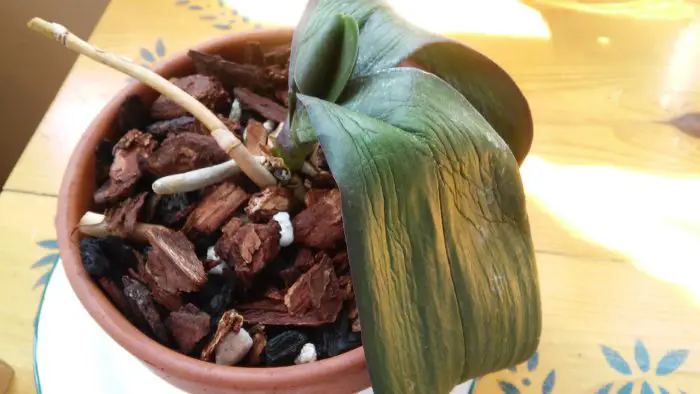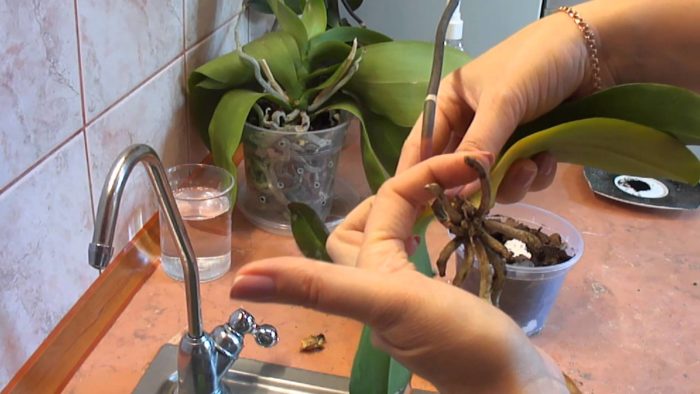Orchid is an amazing plant. She combines a capricious character and amazing vitality. In the process of growing, growers face many problems. Many people ask question why do orchids die? The culture can dry out or completely lose its roots due to decay. But timely measures taken will revive the plant, and it will continue to delight with its flowering for more than one year.

why do orchids die?
The main reasons for the death of orchid are the inconsistency of the conditions of detention with the requirements. Significant temperature changes, waterlogging of the substrate, and a critical lack of lighting can be fatal for it.
Most often, problems arise during the cold season. The flower reacts negatively to the following factors:
- dry air during heating operation;
- cold coming from glass when kept on a window;
- watering with hard water;
- overheating or burns when kept in the sun;
- constantly moist substrate combined with a low temperature;
- excess or improper fertilization;
- violation of aeration of the roots due to a too compacted substrate;
- infestation by insect pests or fungal diseases.
If you do not create the necessary conditions and do not eliminate the factors affecting the well-being of the flower, it will soon begin to die.
Here if you love White Orchid Flower Plant.
How can you tell if an orchid is dying?
It is possible to determine that an orchid is having problems by its appearance. It is worth paying attention to the presence of the following signs:
- lethargic, gradually yellowing leaves;
- yellowing of the shoots, starting from the crown;
- lack of buds (more than 3 months);
- changing the position of the plant in the pot;
- drying and hanging of air roots;
- green bloom and algae inside the pot.
If at least one of these signs is present, it is worth removing the flower from the pot and examining the root system. Signs of root problems:
- brown or black;
- softness to the touch;
- discharge of fluid when pressed;
- filamentous structure.
Can orchids die from overwatering?
Excessive wetting of the substrate is the main mistake of novice florists. The roots of the orchid are special, and you cannot water it like other crops. You can understand that the plant is flooded by the color of the roots in the pot. Then the leaves begin to wrinkle and buds fall off. If you do not take action, the flower will soon begin to die.
Important! Most often, overflow occurs if, when the pot is immersed in a container with water, they forget to remove it in time. The overflowing substrate is detrimental to the orchid.

Steps to revive an overwatered orchid
The only way to deal with overflow or flooded plants is to transplant the flower into the fresh substrate and change the pot. Operating procedure:
- The plant is carefully removed from the pot. It cannot be pulled out, otherwise the roots will break. It is best to carefully cut the pot into two pieces and remove them.
- The substrate is cleaned from the roots, washed with warm water and examined.
- Cut off the rotten parts with sharp, disinfected scissors.
- After drying, the sections are powdered with crushed charcoal or cinnamon.
- Spray the roots with a fungicide and leave the outlet to dry for a day.
- Drainage is laid at the bottom of the new pot, a freshly prepared substrate is poured in a thin layer and an orchid is placed on it. The free space between the roots is covered with a substrate, leaving the root collar on the surface.
Carefully! Inexperienced growers try to dry the waterlogged substrate by warming it up with a hairdryer. The hot air flow acts on the flower like a real hurricane. He will not recover from such help, but will definitely die!
How not to overwater an orchid?
The plant requires a strictly verified substrate moisture in different phases of development, at different temperatures and humidity in the room. Drying and waterlogging are equally dangerous for an orchid.
On average, the frequency of watering is as follows:
- during the active growing season – 2 times a week;
- during flowering and in a very hot period – every other day;
- during the rest period – 1 time in 2-3 weeks.
When regulating moisture, it is also worth considering the type of orchid:
- Cymbidium, Phalaenopsis, Pafiopedilum are watered when perspiration disappears on the inside of the pot walls.
- Cattleya, Oncidium, Odontoglossum, Dendrobium require complete drying of the substrate before the next watering.
- Wanda needs daily spraying from a spray bottle.
Important! For irrigation, use extremely soft, settled or filtered water with a temperature of 30-35 degrees.
Facing the problem Why Are The Flowers Falling Off My Orchid?
how to save dying orchid?
The method of resuscitation of a dying flower depends on its condition and the problem that has arisen.

save with rotten roots
An exotic with completely rotten roots is restored after their complete removal. The florist’s task is to grow a new root system on the surviving outlet.
According to gardeners, the most effective way is to hang the outlet above the water:
- After removing the decayed roots, the sections are dried for several hours and treated with charcoal.
- Water is poured into a transparent vessel and the socket is suspended with a wire so that the lower part is located 1-2 cm short of the liquid.
- The container is installed in a warm (23-25 degrees) room in a place with diffused but intense lighting.
- In the process of growing roots, the level of liquid is monitored and, as necessary, topped up. To prevent the leaves from drying out, they are wiped with a solution of succinic acid or the drug “Doctor Foley”. This will help the orchid gain strength and energy.
New roots are formed within 2-2.5 months. As soon as their length reaches 5-6 cm, the plant is planted in a pot with sphagnum moss. This material has good moisture capacity and at the same time, increased air permeability, which will help a weakened plant to recover faster. After complete resuscitation and root growth, the orchid is transplanted into a substrate familiar for this type of plant.
save Heat Damaged orchid due to overheating
Keeping a crop in a too hot, dry room or in direct sunlight can also kill it. Signs of overheating:
- withering leaves (often with light spots or yellow tips);
- yellowish tinge and puckering of roots;
- dryness and brittleness of the air roots.
When overheated, the plant is removed from the windowsill to a cool place for cooling.
Important! A flower affected by high temperature can be watered only after it has cooled down, after 3-4 hours. Immediate hydration of the substrate will cause instant root death!
orchid flower dul due to lackness of light
Signs of a lack of lighting are shriveled or small leaves with a dull hue. The flower looks drooping, unhealthy, does not bloom for a long time. Gradually, the roots begin to rot, since the processes of photosynthesis are disrupted in them.
It will be possible to revive the plant only if it is provided with bright, diffused lighting for at least 12 hours a day. The best place to grow is an east or west window. In winter or in cloudy weather, the orchid is supplemented with fluorescent or phytolamps.
save sick orchid plant
Waterlogging or overheating of a culture is not only dangerous in and of itself. They provoke the development of diseases on the plant. The signs of diseases depend on their type:
- Fungal – manifested by white or gray bloom, spots, stains on the leaves.
- Bacterial – cause rotting of roots, blackening of leaves and pseudobulbs, followed by their withering away. Often, the leaves are covered with weeping spots, an unpleasant odor emanates from the plant.
In the treatment of fungal diseases, Fitosporin has proven itself well. They are treated 2-3 times with an interval of 7 days.
Bacterial diseases are treatable only at an early stage. First, all the affected parts of the plant are removed, healthy ones are rubbed with antibiotic gruel. Experts advise using the drug Chlorhexidine. To recover after treatment, watering is reduced, the temperature is lowered to 22-23 degrees.
Check out How To Fertilize Indoor Orchid?
Quick First Aid for Dying Orchid
In the matter of saving an exotic (when diagnosing problems), it is important to provide it with first aid correctly. Any disturbance in the appearance of the plant requires immediate action:
- swelling, plaque and yellowing of the leaves cause fungus. The affected parts are removed, the cut sites are treated with a fungicide;
- when bacterial spots appear on old leaves, they are pruned and treated with activated carbon;
- a plant with dried leaves and roots is transplanted into a new substrate;
- if bulky wax growths or holes on the leaves are noticed, they are treated with insecticides against insect pests.
Care after reviving dying orchid
The restoration of the orchid will be quick and successful if you follow the special care rules:
- Gentle, moderate watering (preferably in a tray).
- Pest infestation control.
- Maintaining a comfortable temperature within 22-25 degrees and humidity 50-60%.
Important! In the period after resuscitation, you can not feed the flower or use growth stimulants when watering. An undeveloped root system can get burned or poisoned.
Prevent orchid from dying
Careful adherence to the recommendations for the conditions of maintenance and the rules of care helps to prevent problems when growing an orchid:
- Compliance with watering norms. Phalaenopsis is a special flower that needs to be watered periodically. The next portion of the moisture is added to the substrate only after the roots have absorbed the previous one. The root system must breathe, so it cannot be constantly in the water.
- Providing intensive lighting for at least 12-14 hours a day. Without a lot of scattered sunlight, the plant loses its immunity. The roots weaken and cannot provide it with nutrients.
- Correct feeding. The main enemy of the orchid, leading to root rot, is an excess of nitrogen. Top dressing is carried out taking into account the phase of vegetative development of the plant. In this case, the dosage is reduced by 2-3 times so that overfeeding does not occur.
- Maintaining a humidity level of at least 60%. If there is not enough moisture in the air, the plant pot is placed on a pallet with expanded clay. It must be pre-filled with water, an automatic humidifier must be installed in the room, and the leaves and roots must be sprayed additionally.
Throwing away a sluggish, dry and even rootless orchid is not worth it. With some effort and patience, she can be saved. A life-loving flower “will take advantage of the chance of salvation,” the main thing is to choose the right method. Before using any method of resuscitation, you should first get acquainted with the recommendations of specialists and experienced florists. Wrong actions in this situation can aggravate the deplorable state of the plant.
Conclusion
We have discussed in detail above the answer to the question Why Do Orchids Die. We tell you each and every reason for the death of orchid. Taking complete care of an orchid extends its life span and beauty.